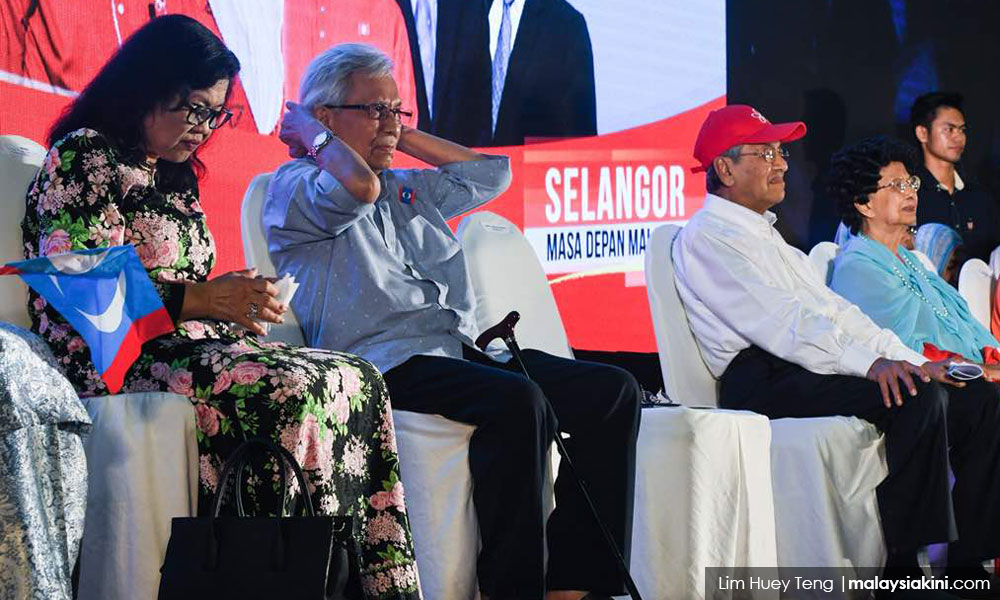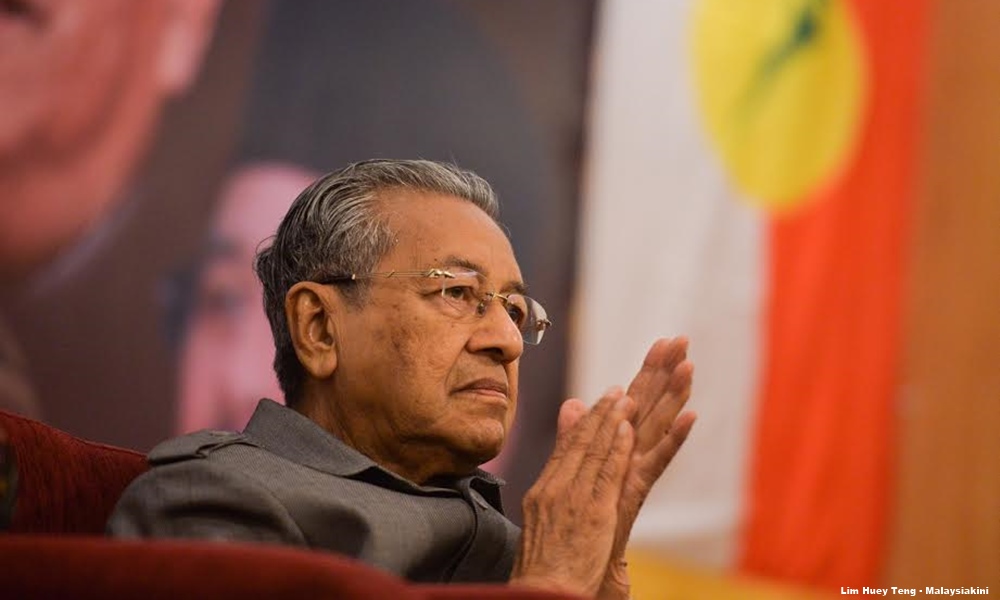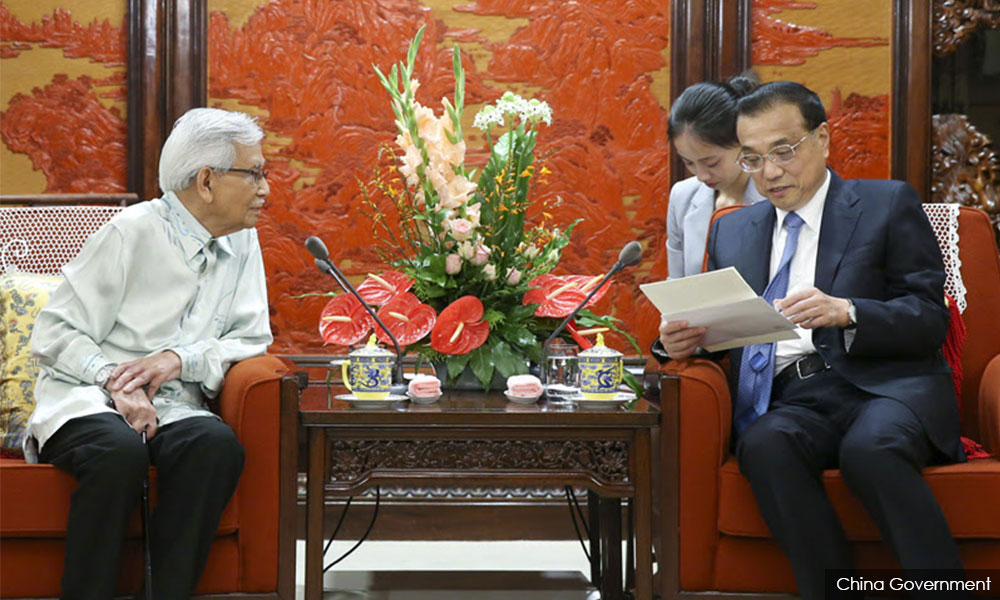DR M IS RIGHT – DAIM IS AS SMART AS THEY COME, SAD TO SAY NO ONE VOTED FOR HIM TO LEAD MALAYSIA: HARAPAN LEADERS NOW FORCED TO FIGHT FOR THEIR LEGITIMATE RIGHT TO GOVERN – OTHERWISE THEY WOULD BE FAILING VOTERS WHO GAVE THEM THE MANDATE & NOT DAIM THE MANDATE TO RULE, EXPERIENCED OR WITHOUT EXPERIENCE
When prime minister Dr Mahathir Mohamad returned to power following the 14th general election, many of his former lieutenants also returned to prominence – perhaps none more so Daim Zainuddin.
One of Mahathir’s first acts in office was to form the Council of Eminent Persons (CEP) – an influential five-member advisory body with Daim at the helm.
“Many of us have little or no experience in running a government. We need some expertise on this.
“Of course, expertise must come from people with knowledge or previous knowledge of administration, or being in the government, or having held some responsible post.
“(That is why) we have decided to set up a council of elders, or rather a council of eminent persons,” he said at the time.
Daim had previously retired from politics in 2001. In the years leading up to the election, he had largely kept a low profile until he joined Pakatan Harapan on the campaign trail, although he had previously been openly critical of then-prime minister Najib Abdul Razak’s administration.

However, the relationship between Daim and Mahathir is close, and goes back decades.
Kedah origins
Like his close friend, Daim comes from Alor Setar. Born in Derga in Alort Setar on April 29, 1938, Diam was the youngest of 13 children. His father was a Kedah government clerk while his mother was a homemaker.
He was schooled first at the Seberang Perak Malay School, followed by the Sultan Abdul Hamid College and the St Xavier Institution in Penang, before returning to Sultan Abdul Hamid College as an attachment teacher.
His mother, Pok Rafeah, then sold some land to raise funds for Daim to study law at Lincoln’s Inn in the UK. He was called to the English Bar in 1959.
For the next ten years, he had been a private lawyer, deputy public prosecutor, magistrate, and Sessions Court judge, but then went into the business world.
His first few ventures failed, but was able to recoup his losses through his subsequent investments, including steel and iron product manufacturing, snack food manufacturing, plastic packaging, and property.
In 1973, his property company acquired a lucrative piece of land in Cheras that helped launched his property development career. Asiaweek reported in 1982 that this was due to Daim’s close association with the then-Selangor menteri besar Harun Idris.
It was around this time that Daim became Mahathir’s close associate, just as Mahathir was making a comeback in Umno after a period of political exile following a fallout with Tunku Abdul Rahman.
In 1976, Daim had just finished a two-year urban planning study at University of Berkeley, California and was appointed as the chairperson of the property developer Peremba, which was then owned by the Urban Development Authority.
Mahathir was in his third year as deputy prime minister at the time.

When Mahathir became Umno president and prime minister in 1981, Daim was appointed to head the party’s investment arm Fleet Holdings Sdn Bhd in the following year.
In 1984, he was appointed as the party treasurer. In national politics, he was also appointed senator in 1980, and was elected Kuala Muda MP in 1982.
Daim’s Boys
The next few years proved interesting for Daim: He was managing government investments in Peremba, in charge of Umno investments in Fleet Holdings, while still being a private businessperson.
This led to several major business deals and speculation that he had been among the richest people in Malaysia – perhaps Asia – at the time.
His total net assets were estimated to be RM843.32 million in 1984, when he joined the cabinet for the first time as finance minister.
But these successes were accompanied by allegations of conflict of interests due to his overlapping roles in handling government investments and his private ventures.
Throughout his years in Paremba, he had also helped groom many major corporate figures.
His associates, dubbed ‘Daim’s Boys’, included Wan Azmi Wan Hamzah who later became Malayan Banking Bhd CEO, Abdul Rashid Abdul Manaf who later became chairperson at SP Setia and Eco World director, and Robert Tan, who held significant stakes in public listed companies.
Another notable figure is Tajudin Ramli, who later became CEO of Malaysian Airlines.
When the cabinet ordered Daim to divest his business interests in 1986, he was revealed to have business interests in United Malayan Banking Corporation (eventually becoming part of RHB Bank), Sime Darby, Technology Resources Industries (TRI), System Televisyen Malaysia (TV3), Cold Storage, Guthrie Ropel, Maybank, Tasik Cement, Oriental Holdings, Bolton Properties, Idris Hydraulic, Malayan Flour, Industrial Oxygen and Syarikat Permodalan & Perusahaan Perak.
Yet, it was speculated that Daim’s rapid rise in power under Mahathir’s leadership was because he appeared politically unambitious, yet had great financial acumen and knew how to get things done.
Finance minister
Daim’s best known official position prior to this CEP appointment is perhaps his two terms in Mahathir’s cabinet as finance minister from 1984 to 1991 and from 1998 to 2001 when he retired.
Both terms had been during trying times for the Malaysian economy – he was tasked with plugging leakages and pared down on Malaysia’s external debt sooner than expected during his first tenure. During his second, he took charge of an economy still reeling from the Asian financial crisis.
But that did not mean Mahathir had no use for him after his first resignation in 1991. Instead, Mahathir had retained him in the intervening years as economic adviser and his personal envoy abroad.
For example, Mahathir reportedly sent Daim to the US and successfully persuaded the country to limit its release of tin stockpiles, which was causing a decline in tin prices and hurting the tin industry in Malaysia.
Daim was also reportedly the brains behind many of Mahathir’s policies at the time.
“(He) knows the nitty-gritty, the way to carry out (the policies). For example, if I say privatisation, his job is to find the means of privatising. He showed how it should be done and all that,” Mahathir was once quoted as saying.
Wanted to stay retired
Daim resigned from the cabinet for a second time in 2001, just two years before Mahathir announced his intention to resign his premiership and Umno presidency.
He said in a 2004 interview that he had retired, and told reporters last year that he intends to stay retired after the 14th general election.
Nevertheless, he was appointed CEP chairperson within days after Mahathir was sworn in.
In that capacity, the CEP began to hold hearings to receive feedback for the government, and also set up the Institutional Reform Committee and the 1MDB Committee.

Daim also had gone to China in July to negotiate several projects between Malaysian and China that had been signed by the previous administration, ahead of Mahathir own visit on Thursday.
This was not without controversy. Opposition MPs such as Khairy Jamaluddin Abu Bakar expressed concern that the CEP may have overstepped its advisory role, while Singapore’s Straits Times reported that there had been murmurs of discontent amongst civil servants and Pakatan Harapan politicians over its influence.
This has not been the first time Daim and the CEP have been accused of overstepping their duties, however.
It was revealed Daim allegedly asked then chief justice Md Raus Sharif and Court of Appeal president Zulkefli Ahmad Makinudin to resign back in June – a move which was backed by the prime minister.
Despite this, it would appear that the CEP – and by extension, Daim – are set to stay on beyond Pakatan Harapan’s first 100 days in power.
“Some think that CEP has come to the end, but I haven’t decided.
“I didn’t say anything about 100 days. I still need their services,” Mahathir said.
In a recent interview with Malaysiakini, the premier said the CEP still had “a lot of work to do” as there were things he could not personally attend to.
“I can’t be interviewing people, asking them about their background and doing research and all that,” he said.
Previously, several media outlets quoted Mahathir saying that the CEP would help shape policies to deliver Pakatan Harapan’s 100-day promises, and that would also be the CEP’s lifespan.
– M’kini
✍ Sumber Pautan : ☕ Malaysians Must Know the TRUTH
Kredit kepada pemilik laman asal dan sekira berminat untuk meneruskan bacaan sila klik link atau copy paste ke web server : https://ift.tt/2ocg2t1
(✿◠‿◠)✌ Mukah Pages : Pautan Viral Media Sensasi Tanpa Henti. Memuat-naik beraneka jenis artikel menarik setiap detik tanpa henti dari pelbagai sumber. Selamat membaca dan jangan lupa untuk 👍 Like & 💕 Share di media sosial anda!



















Post a Comment